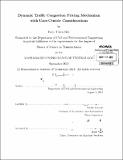Dynamic traffic congestion pricing mechanism with user-centric considerations
Author(s)
Bui, Kim Thien
DownloadFull printable version (7.168Mb)
Other Contributors
Massachusetts Institute of Technology. Department of Civil and Environmental Engineering.
Advisor
Emilio Frazzoli.
Terms of use
Metadata
Show full item recordAbstract
In this thesis, we consider the problem of designing real-time traffic routing systems in urban areas. Optimal dynamic routing for multiple passengers is known to be computationally hard due to its combinatorial nature. To overcome this difficulty, we propose a novel mechanism called User-Centric Dynamic Pricing (UCDP) based on recent advances in algorithmic mechanism design. The mechanism allows for congestion-free traffic in general road networks with heterogeneous users, while satisfying each user's travel preference. The mechanism first informs whether a passenger should use public transportation or the road network. In the latter case, a passenger reports his maximum accepted travel time with a lower bound announced publicly by the road authority. The mechanism then assigns the passenger a path that matches with his preference given the current traffic condition in the network. The proposed mechanism introduces a fairness constrained shortest path (FCSP) problem with a special structure, thus enabling polynomial time computation of path allocation that maximizes the sequential social surplus and guarantees fairness among passengers. The tolls of paths are then computed according to marginal cost payments. We show that reporting true preference is a weakly dominant strategy. The performance of the proposed mechanism is demonstrated on several simulated routing experiments in comparison to user equilibrium and system optimum.
Description
Thesis: S.M. in Transportation, Massachusetts Institute of Technology, Department of Civil and Environmental Engineering, 2013. Cataloged from PDF version of thesis. Includes bibliographical references (pages 85-95).
Date issued
2013Department
Massachusetts Institute of Technology. Department of Civil and Environmental EngineeringPublisher
Massachusetts Institute of Technology
Keywords
Civil and Environmental Engineering.